stat_summary() 對唯一的 x 或 y 進行操作; stat_summary_bin() 對分箱的 x 或 y 進行操作。它們是 stat_bin() 的更靈活版本:它們不僅可以計算,還可以計算任何聚合。
用法
stat_summary_bin(
mapping = NULL,
data = NULL,
geom = "pointrange",
position = "identity",
...,
fun.data = NULL,
fun = NULL,
fun.max = NULL,
fun.min = NULL,
fun.args = list(),
bins = 30,
binwidth = NULL,
breaks = NULL,
na.rm = FALSE,
orientation = NA,
show.legend = NA,
inherit.aes = TRUE,
fun.y = deprecated(),
fun.ymin = deprecated(),
fun.ymax = deprecated()
)
stat_summary(
mapping = NULL,
data = NULL,
geom = "pointrange",
position = "identity",
...,
fun.data = NULL,
fun = NULL,
fun.max = NULL,
fun.min = NULL,
fun.args = list(),
na.rm = FALSE,
orientation = NA,
show.legend = NA,
inherit.aes = TRUE,
fun.y = deprecated(),
fun.ymin = deprecated(),
fun.ymax = deprecated()
)參數
- mapping
-
由
aes()創建的一組美學映射。如果指定且inherit.aes = TRUE(默認),它將與繪圖頂層的默認映射組合。如果沒有繪圖映射,則必須提供mapping。 - data
-
該層要顯示的數據。有以下三種選擇:
如果默認為
NULL,則數據繼承自ggplot()調用中指定的繪圖數據。data.frame或其他對象將覆蓋繪圖數據。所有對象都將被強化以生成 DataFrame 。請參閱fortify()將為其創建變量。將使用單個參數(繪圖數據)調用
function。返回值必須是data.frame,並將用作圖層數據。可以從formula創建function(例如~ head(.x, 10))。 - geom
-
用於顯示數據的幾何對象,可以作為
ggprotoGeom子類,也可以作為命名去除geom_前綴的幾何對象的字符串(例如"point"而不是"geom_point") - position
-
位置調整,可以是命名調整的字符串(例如
"jitter"使用position_jitter),也可以是調用位置調整函數的結果。如果需要更改調整設置,請使用後者。 - ...
-
其他參數傳遞給
layer()。這些通常是美學,用於將美學設置為固定值,例如colour = "red"或size = 3。它們也可能是配對的 geom/stat 的參數。 - fun.data
-
給出完整數據的函數,應返回包含變量
ymin、y和ymax的數據幀。 - fun.min, fun, fun.max
-
或者,提供三個單獨的函數,每個函數都傳遞一個值向量並應返回一個數字。
- fun.args
-
傳遞給函數的可選附加參數。
- bins
-
箱子數量。被
binwidth覆蓋。默認為 30。 - binwidth
-
箱子的寬度。可以指定為數值或根據未縮放的 x 計算寬度的函數。這裏,"unscaled x" 指的是應用任何尺度變換之前數據中的原始 x 值。當指定函數和分組結構時,每個組將調用該函數一次。默認是使用
bins中的 bin 數量,覆蓋數據範圍。您應該始終覆蓋此值,探索多個寬度以找到最能說明數據中的故事的寬度。日期變量的 bin 寬度是每個時間的天數;時間變量的 bin 寬度是秒數。
- breaks
-
或者,您可以提供給出 bin 邊界的數值向量。覆蓋
binwidth、bins、center和boundary。 - na.rm
-
如果
FALSE,則默認缺失值將被刪除並帶有警告。如果TRUE,缺失值將被靜默刪除。 - orientation
-
層的方向。默認值 (
NA) 自動根據美學映射確定方向。萬一失敗,可以通過將orientation設置為"x"或"y"來顯式給出。有關更多詳細信息,請參閱方向部分。 - show.legend
-
合乎邏輯的。該層是否應該包含在圖例中?
NA(默認值)包括是否映射了任何美學。FALSE從不包含,而TRUE始終包含。它也可以是一個命名的邏輯向量,以精細地選擇要顯示的美學。 - inherit.aes
-
如果
FALSE,則覆蓋默認美學,而不是與它們組合。這對於定義數據和美觀的輔助函數最有用,並且不應繼承默認繪圖規範的行為,例如borders()。 - fun.ymin, fun.y, fun.ymax
-
請改用上麵指定的版本。
方向
該幾何體以不同的方式對待每個軸,因此可以有兩個方向。通常,方向很容易從給定映射和使用的位置比例類型的組合中推斷出來。因此,ggplot2 默認情況下會嘗試猜測圖層應具有哪個方向。在極少數情況下,方向不明確,猜測可能會失敗。在這種情況下,可以直接使用 orientation 參數指定方向,該參數可以是 "x" 或 "y" 。該值給出了幾何圖形應沿著的軸,"x" 是您期望的幾何圖形的默認方向。
函數匯總
您可以單獨提供匯總函數( fun 、 fun.max 、 fun.min ),也可以作為單個函數( fun.data )提供:
- fun.data
-
完整的匯總函數。應該以數值向量作為輸入並返回數據幀作為輸出
- fun.min
-
最小匯總函數(應采用數值向量並返回單個數字)
- fun
-
主要摘要函數(應采用數值向量並返回單個數字)
- fun.max
-
最大匯總函數(應采用數值向量並返回單個數字)
簡單的向量函數最容易使用,因為您可以返回單個數字,但靈活性稍差。如果您的匯總函數一次計算多個值(例如最小值和最大值),請使用 fun.data 。
fun.data 將接收數據,就好像數據沿 x 軸定向一樣,並應返回與該方向相對應的 data.frame。如果該層沿 y 軸定向,則該層將負責翻轉輸入和輸出。
如果未提供聚合函數,則默認為 mean_se() 。
也可以看看
geom_errorbar() , geom_pointrange() , geom_linerange() , geom_crossbar() 用於geoms顯示匯總數據
例子
d <- ggplot(mtcars, aes(cyl, mpg)) + geom_point()
d + stat_summary(fun.data = "mean_cl_boot", colour = "red", linewidth = 2, size = 3)
 # Orientation follows the discrete axis
ggplot(mtcars, aes(mpg, factor(cyl))) +
geom_point() +
stat_summary(fun.data = "mean_cl_boot", colour = "red", linewidth = 2, size = 3)
# Orientation follows the discrete axis
ggplot(mtcars, aes(mpg, factor(cyl))) +
geom_point() +
stat_summary(fun.data = "mean_cl_boot", colour = "red", linewidth = 2, size = 3)
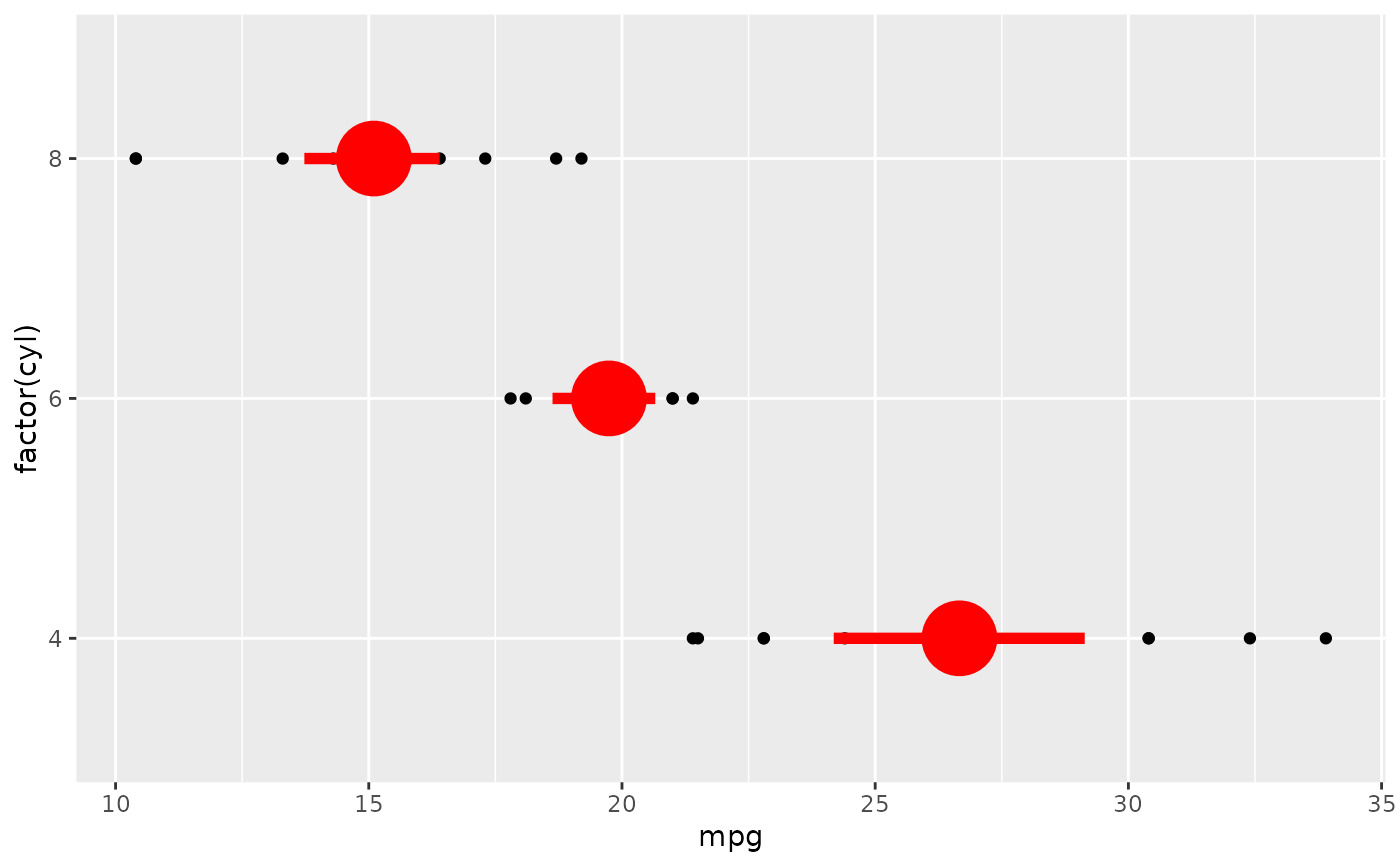 # You can supply individual functions to summarise the value at
# each x:
d + stat_summary(fun = "median", colour = "red", size = 2, geom = "point")
# You can supply individual functions to summarise the value at
# each x:
d + stat_summary(fun = "median", colour = "red", size = 2, geom = "point")
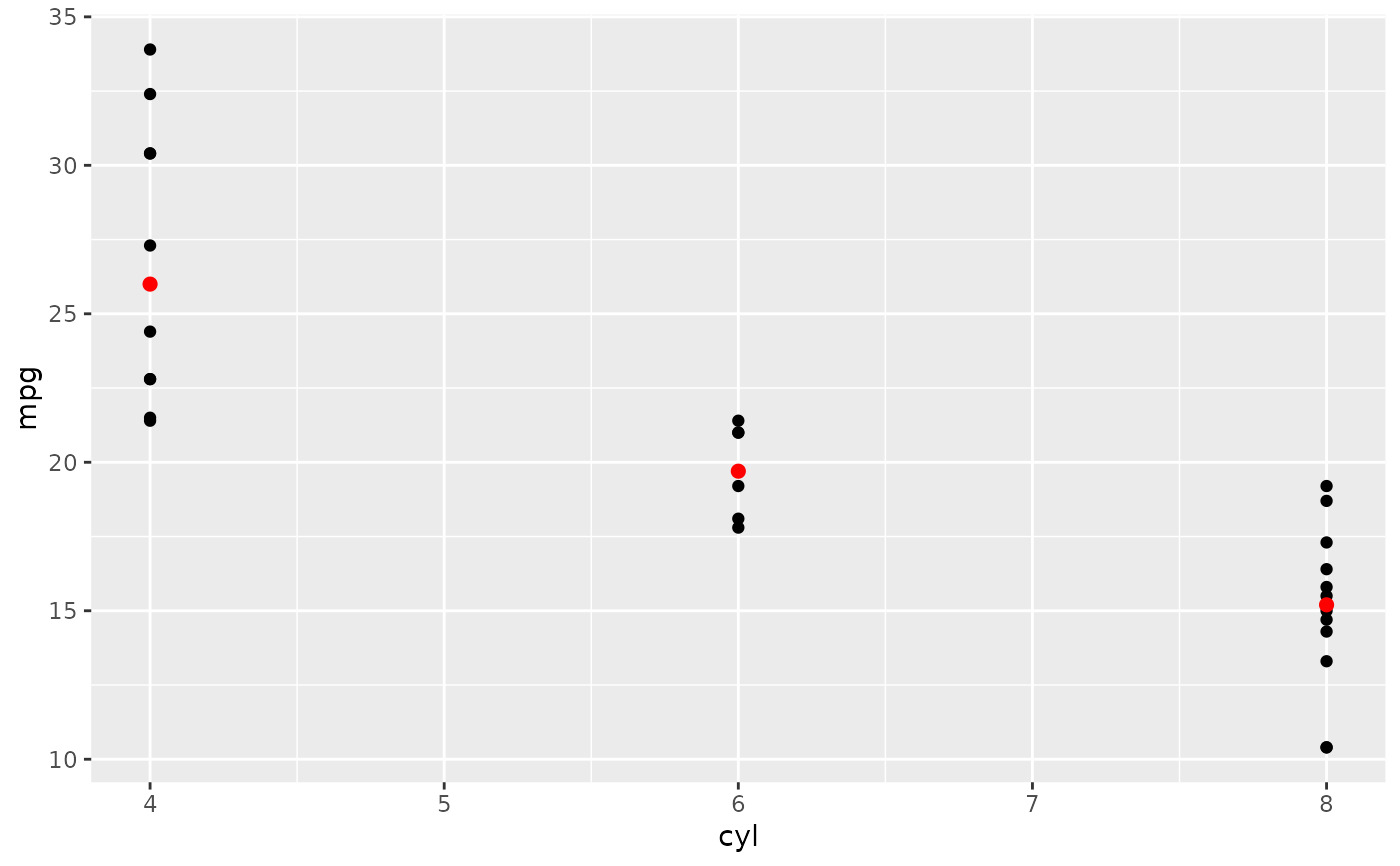 d + stat_summary(fun = "mean", colour = "red", size = 2, geom = "point")
d + stat_summary(fun = "mean", colour = "red", size = 2, geom = "point")
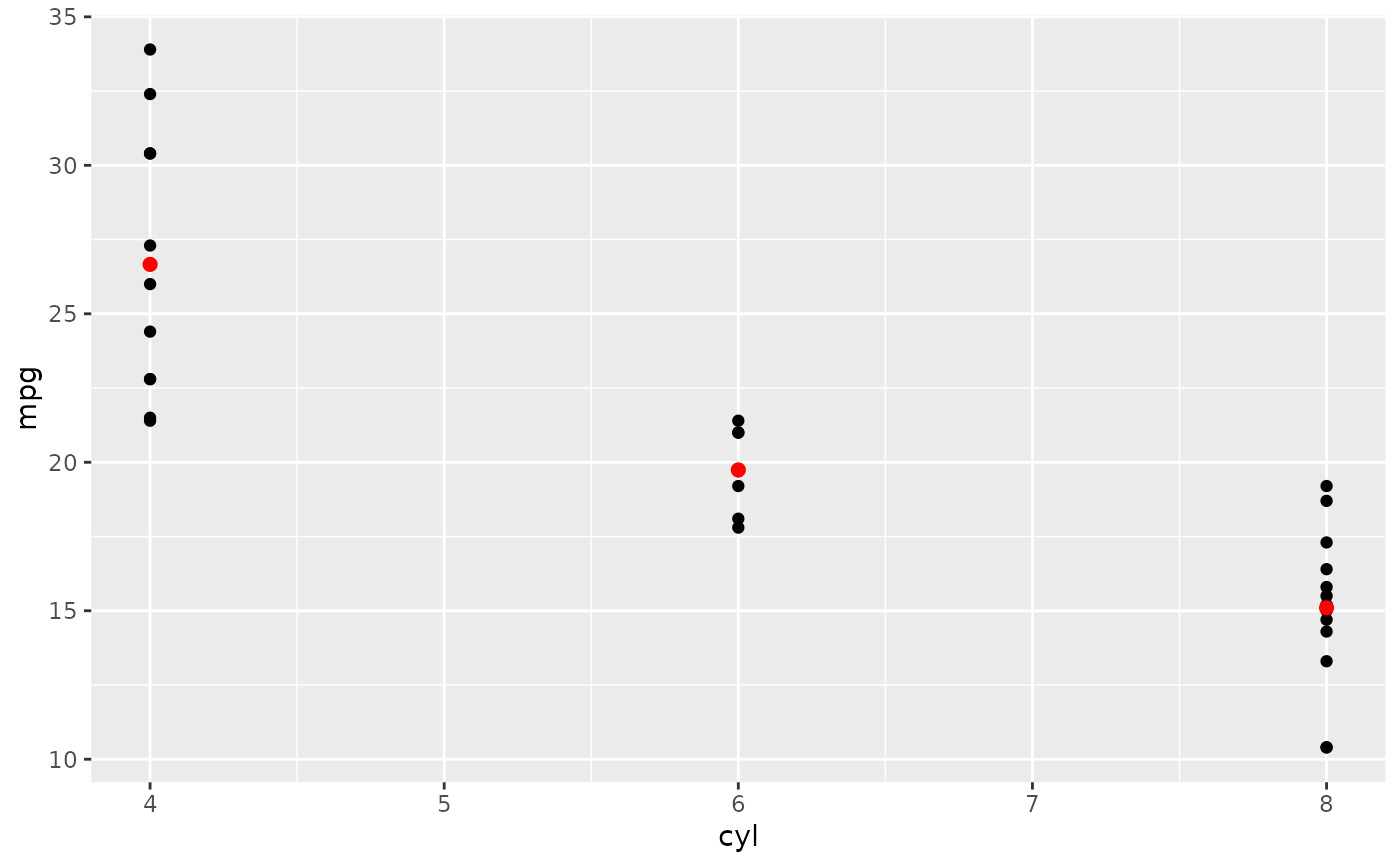 d + aes(colour = factor(vs)) + stat_summary(fun = mean, geom="line")
d + aes(colour = factor(vs)) + stat_summary(fun = mean, geom="line")
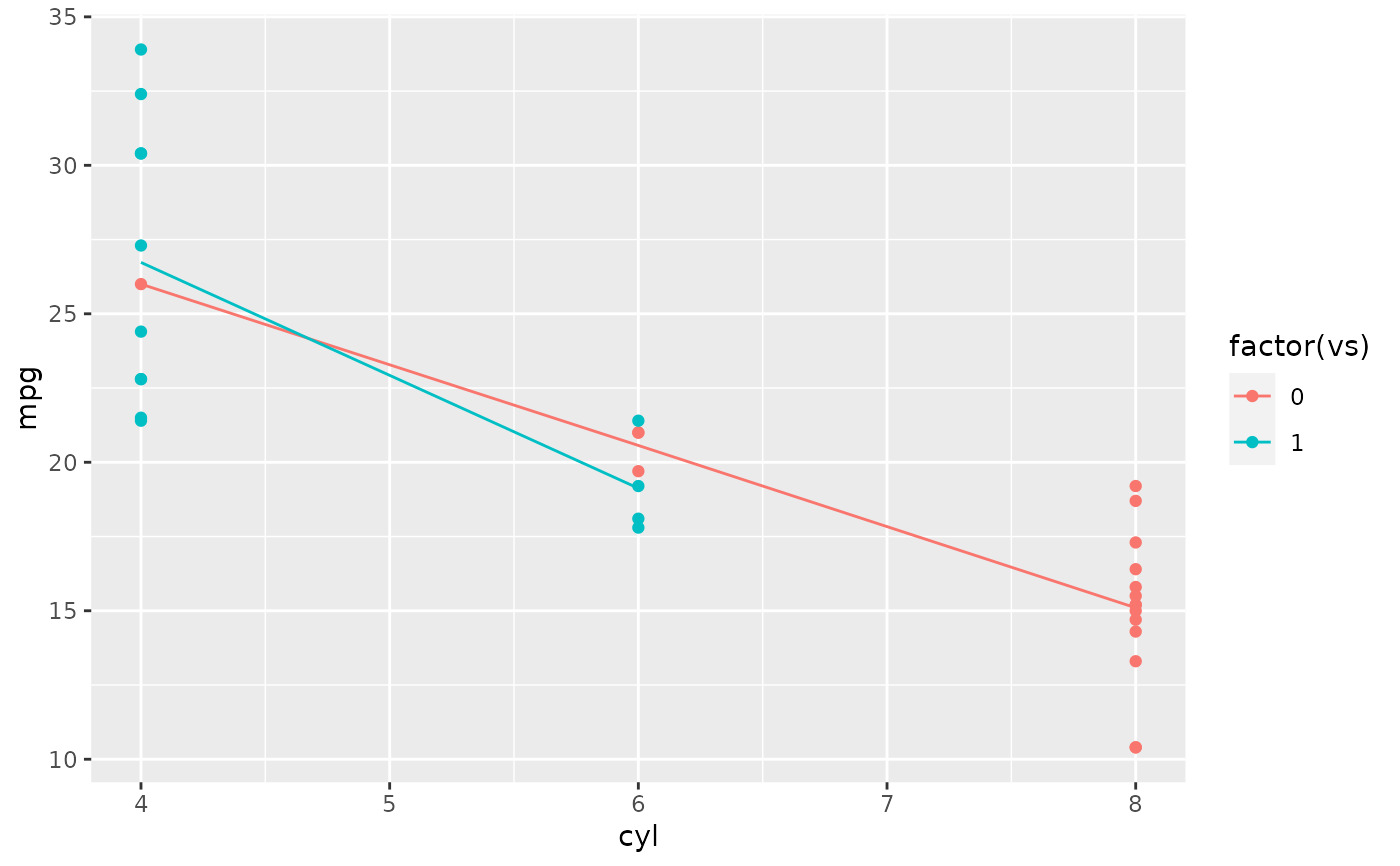 d + stat_summary(fun = mean, fun.min = min, fun.max = max, colour = "red")
d + stat_summary(fun = mean, fun.min = min, fun.max = max, colour = "red")
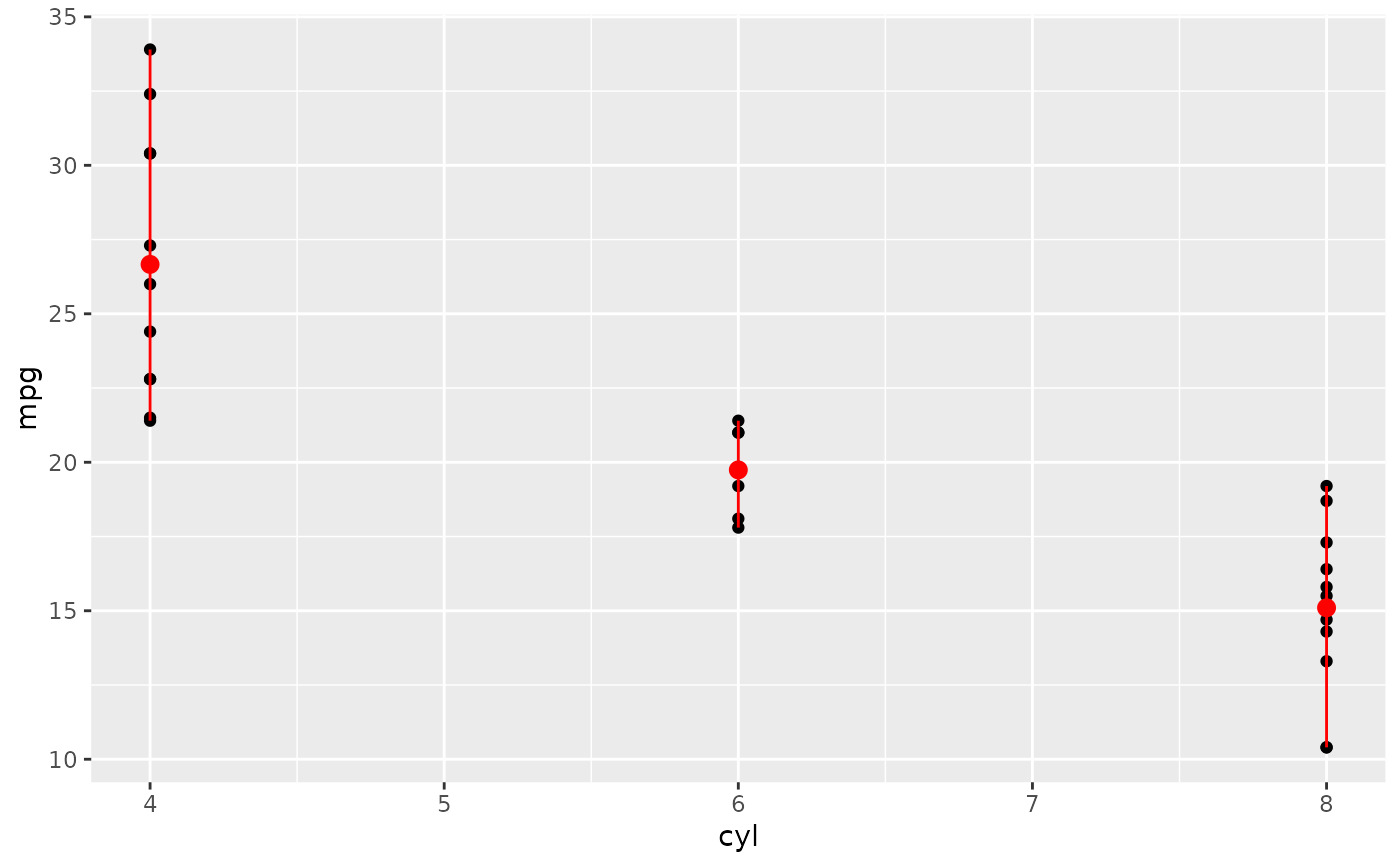 d <- ggplot(diamonds, aes(cut))
d + geom_bar()
d <- ggplot(diamonds, aes(cut))
d + geom_bar()
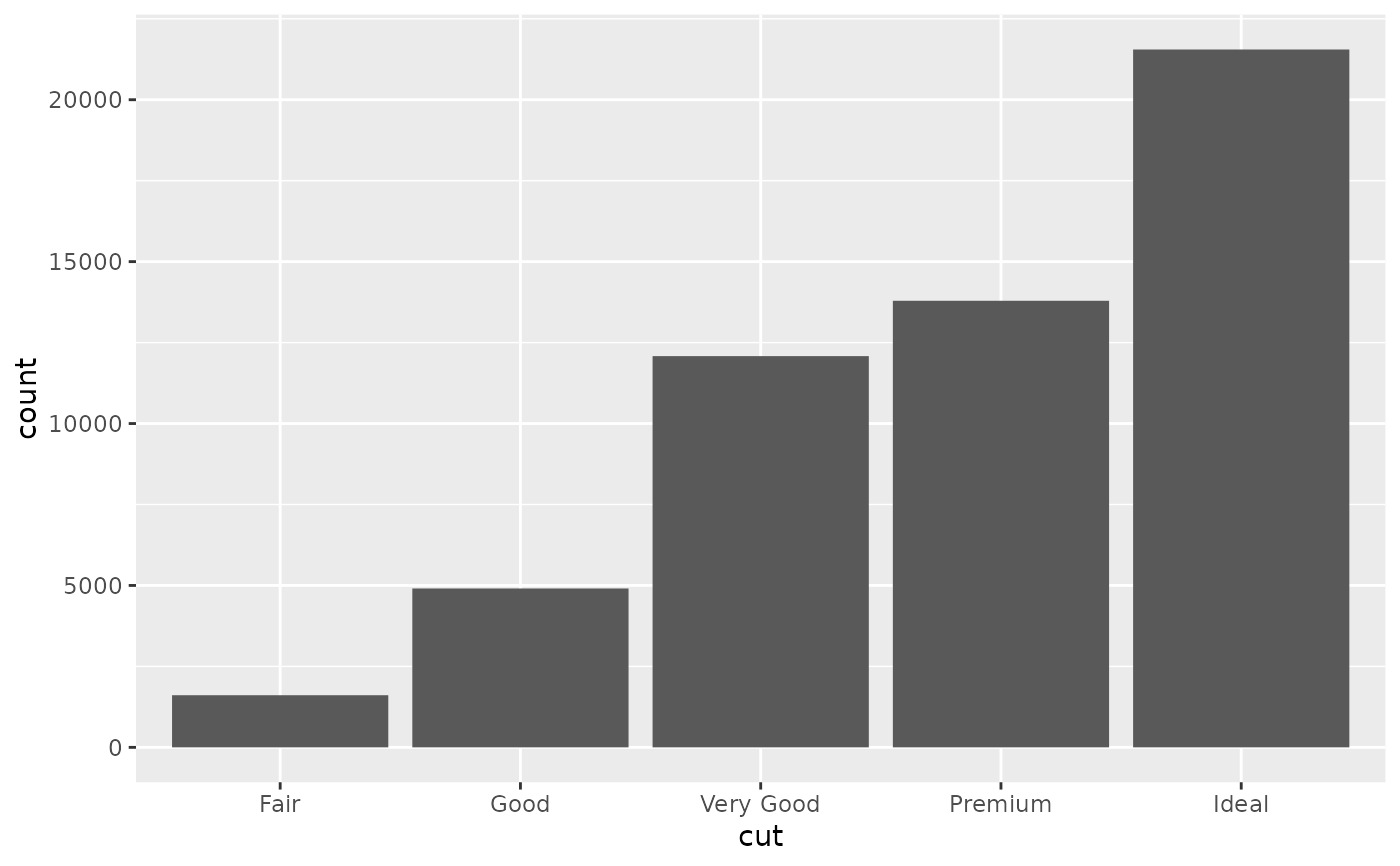 d + stat_summary(aes(y = price), fun = "mean", geom = "bar")
d + stat_summary(aes(y = price), fun = "mean", geom = "bar")
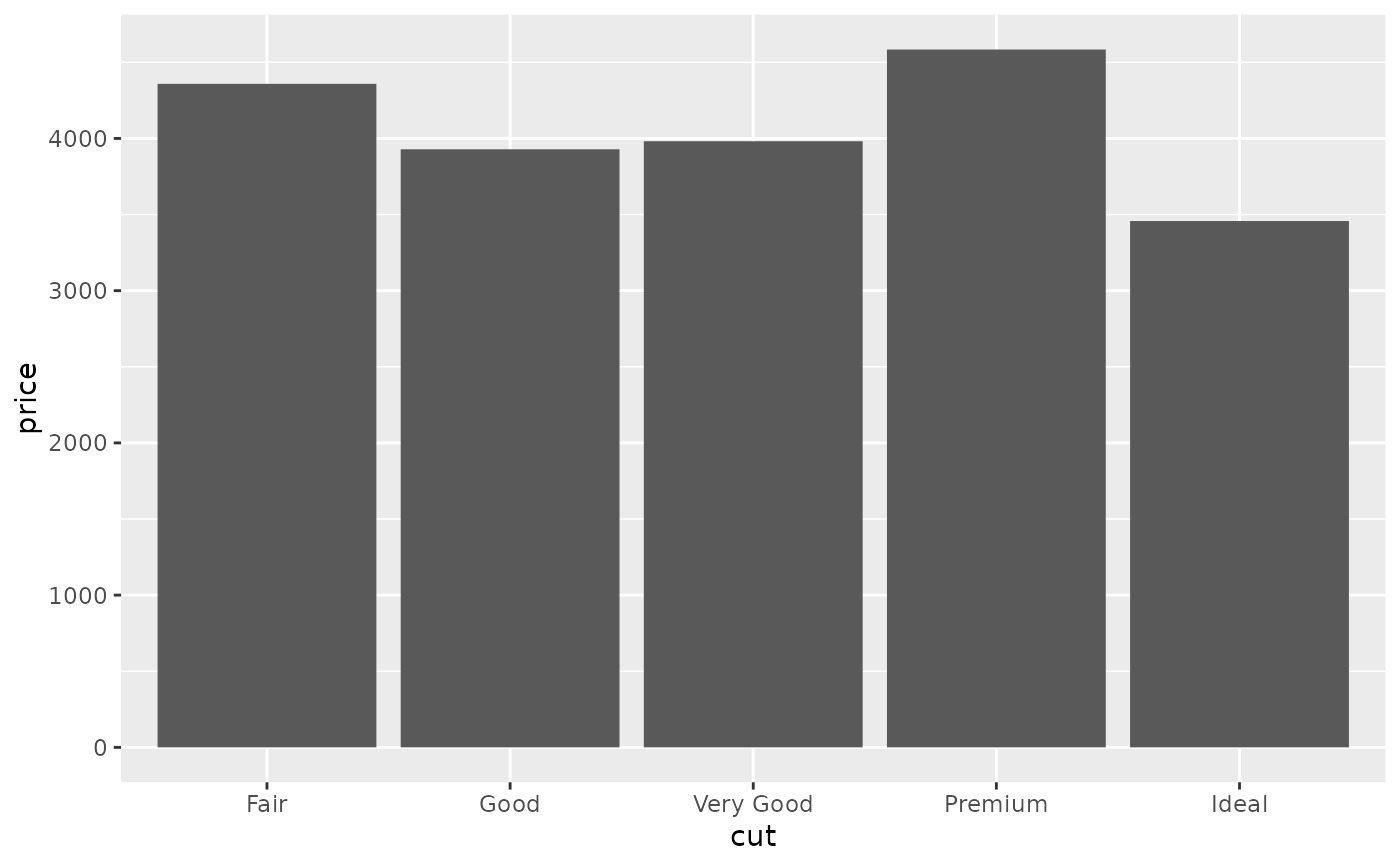 # Orientation of stat_summary_bin is ambiguous and must be specified directly
ggplot(diamonds, aes(carat, price)) +
stat_summary_bin(fun = "mean", geom = "bar", orientation = 'y')
# Orientation of stat_summary_bin is ambiguous and must be specified directly
ggplot(diamonds, aes(carat, price)) +
stat_summary_bin(fun = "mean", geom = "bar", orientation = 'y')
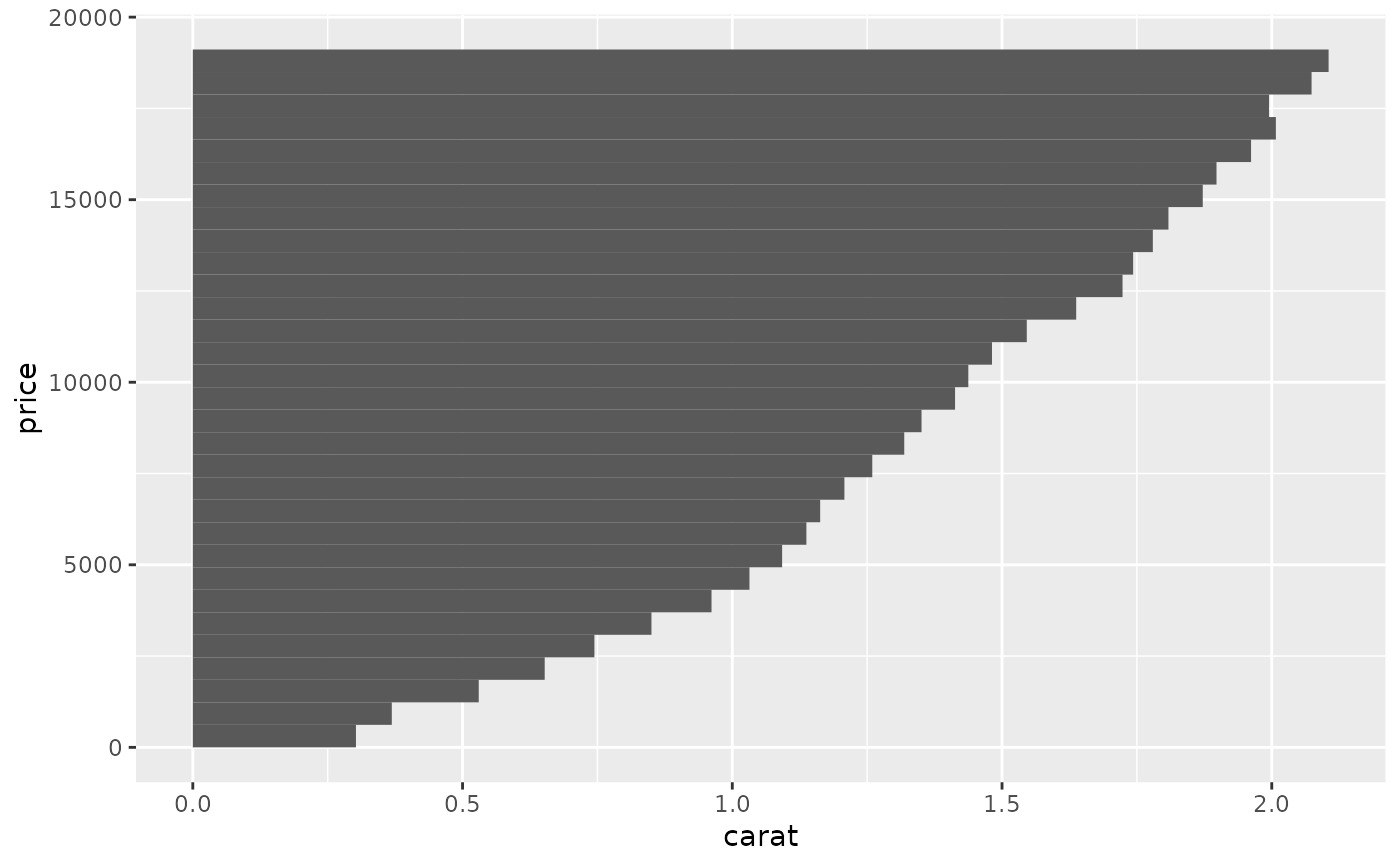 # \donttest{
# Don't use ylim to zoom into a summary plot - this throws the
# data away
p <- ggplot(mtcars, aes(cyl, mpg)) +
stat_summary(fun = "mean", geom = "point")
p
# \donttest{
# Don't use ylim to zoom into a summary plot - this throws the
# data away
p <- ggplot(mtcars, aes(cyl, mpg)) +
stat_summary(fun = "mean", geom = "point")
p
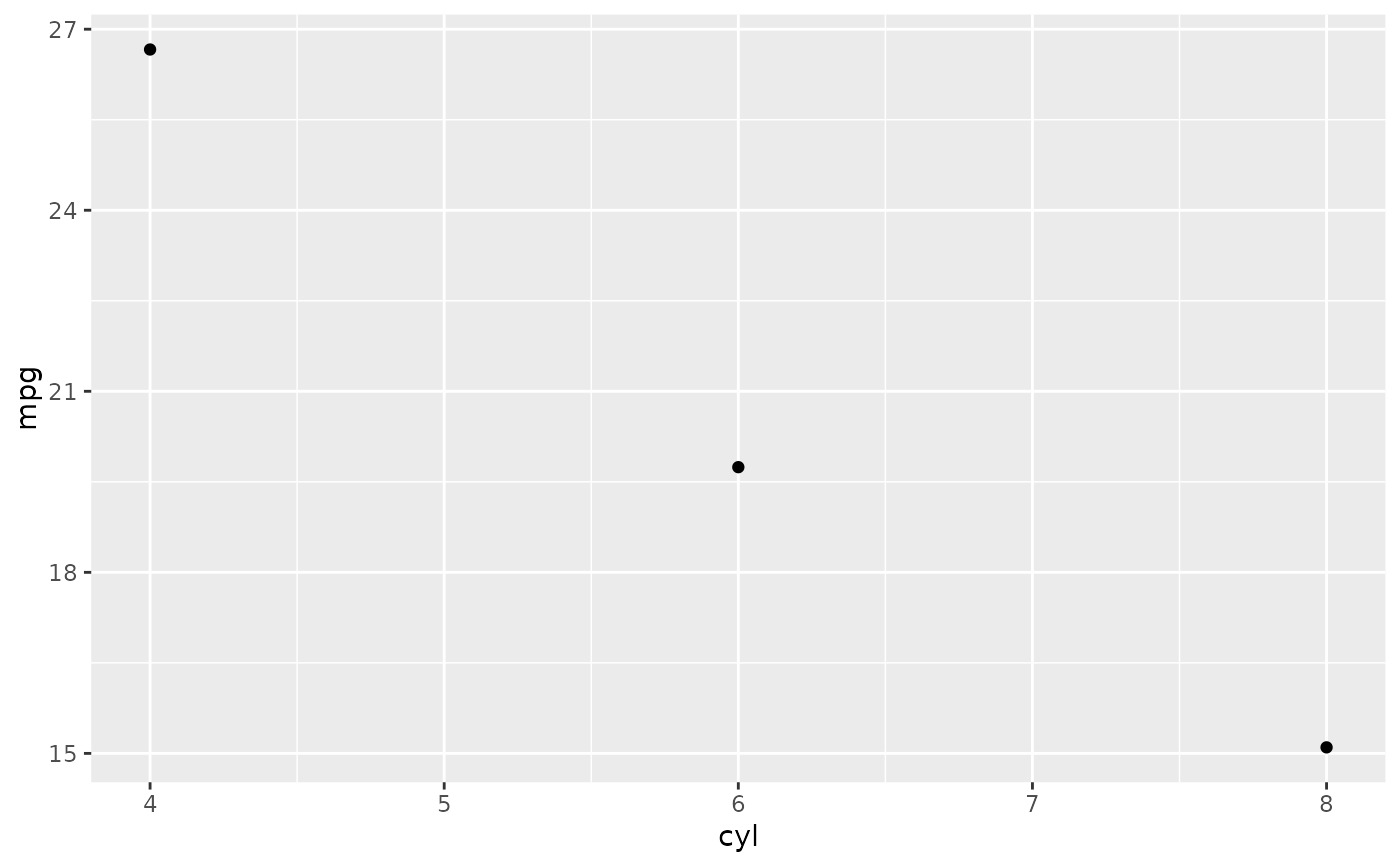 p + ylim(15, 30)
#> Warning: Removed 9 rows containing non-finite values (`stat_summary()`).
p + ylim(15, 30)
#> Warning: Removed 9 rows containing non-finite values (`stat_summary()`).
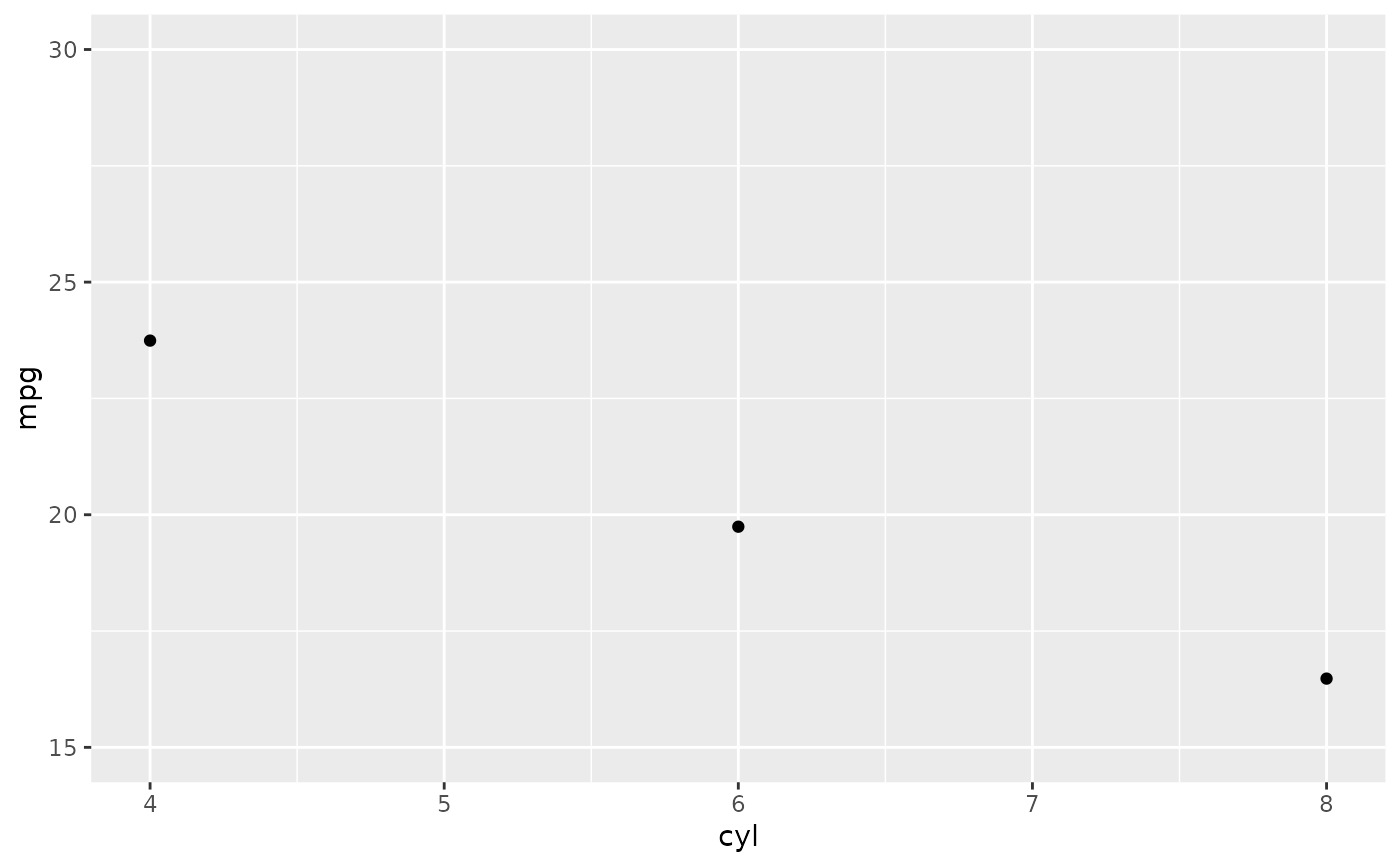 # Instead use coord_cartesian
p + coord_cartesian(ylim = c(15, 30))
# Instead use coord_cartesian
p + coord_cartesian(ylim = c(15, 30))
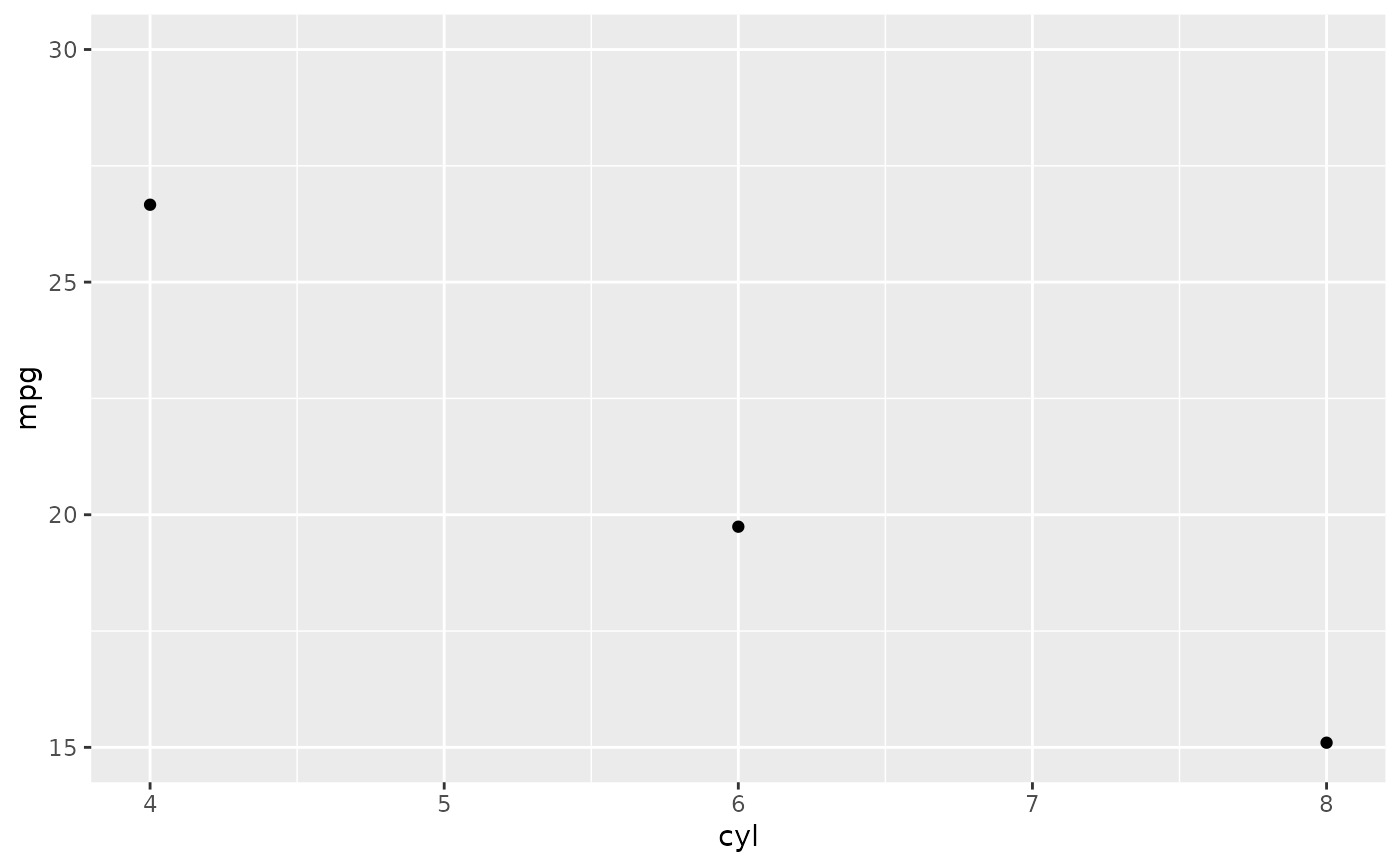 # A set of useful summary functions is provided from the Hmisc package:
stat_sum_df <- function(fun, geom="crossbar", ...) {
stat_summary(fun.data = fun, colour = "red", geom = geom, width = 0.2, ...)
}
d <- ggplot(mtcars, aes(cyl, mpg)) + geom_point()
# The crossbar geom needs grouping to be specified when used with
# a continuous x axis.
d + stat_sum_df("mean_cl_boot", mapping = aes(group = cyl))
# A set of useful summary functions is provided from the Hmisc package:
stat_sum_df <- function(fun, geom="crossbar", ...) {
stat_summary(fun.data = fun, colour = "red", geom = geom, width = 0.2, ...)
}
d <- ggplot(mtcars, aes(cyl, mpg)) + geom_point()
# The crossbar geom needs grouping to be specified when used with
# a continuous x axis.
d + stat_sum_df("mean_cl_boot", mapping = aes(group = cyl))
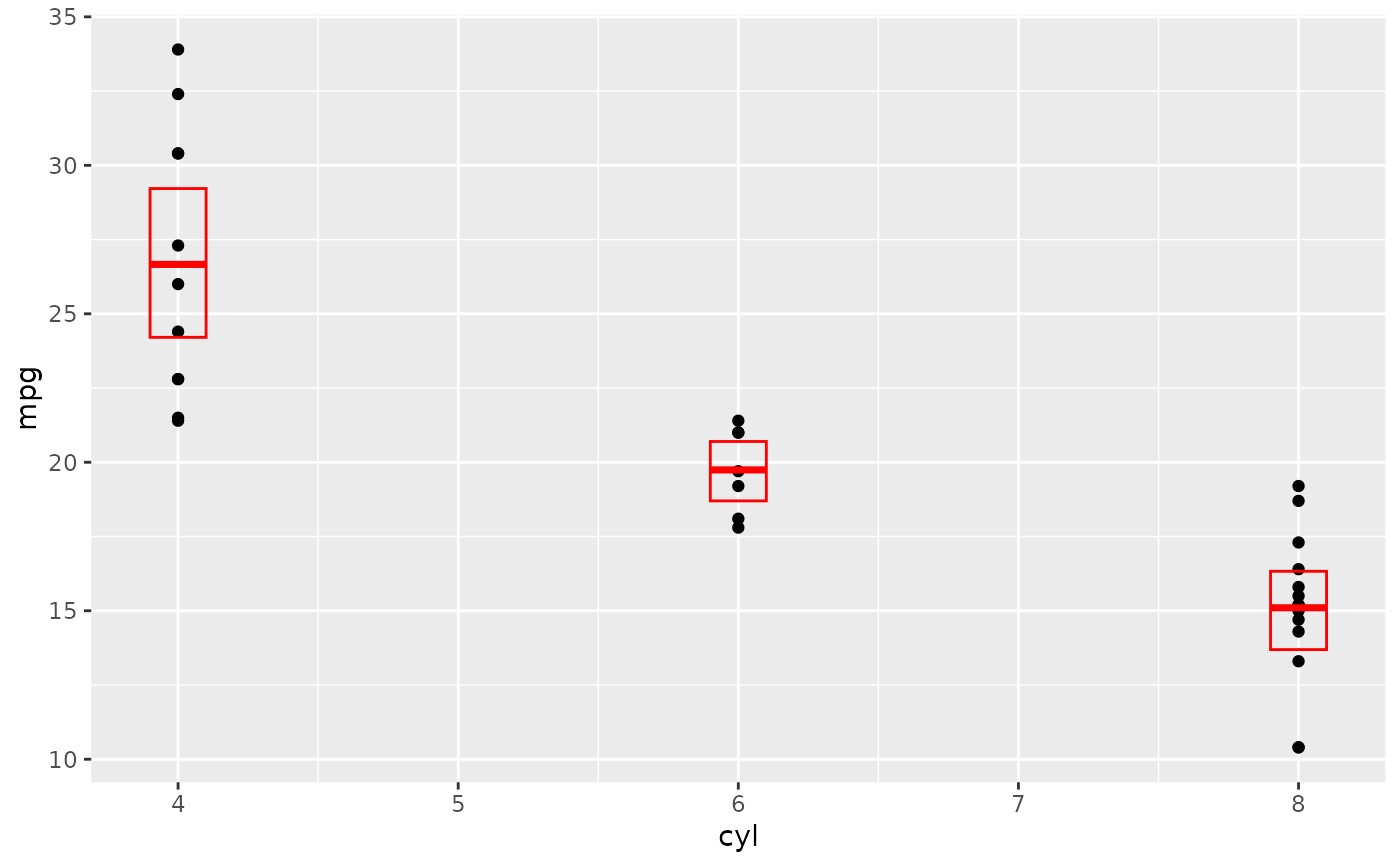 d + stat_sum_df("mean_sdl", mapping = aes(group = cyl))
d + stat_sum_df("mean_sdl", mapping = aes(group = cyl))
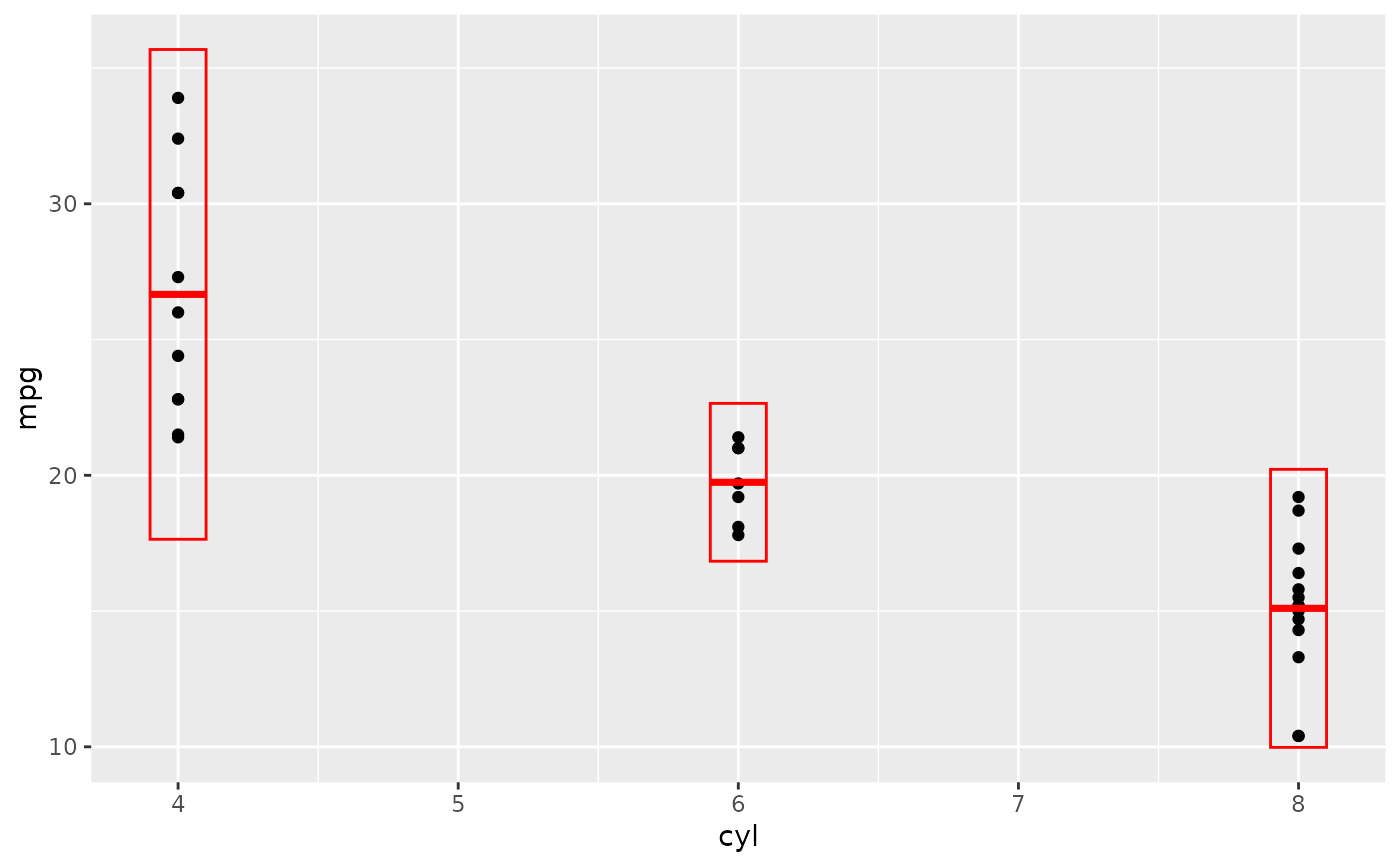 d + stat_sum_df("mean_sdl", fun.args = list(mult = 1), mapping = aes(group = cyl))
d + stat_sum_df("mean_sdl", fun.args = list(mult = 1), mapping = aes(group = cyl))
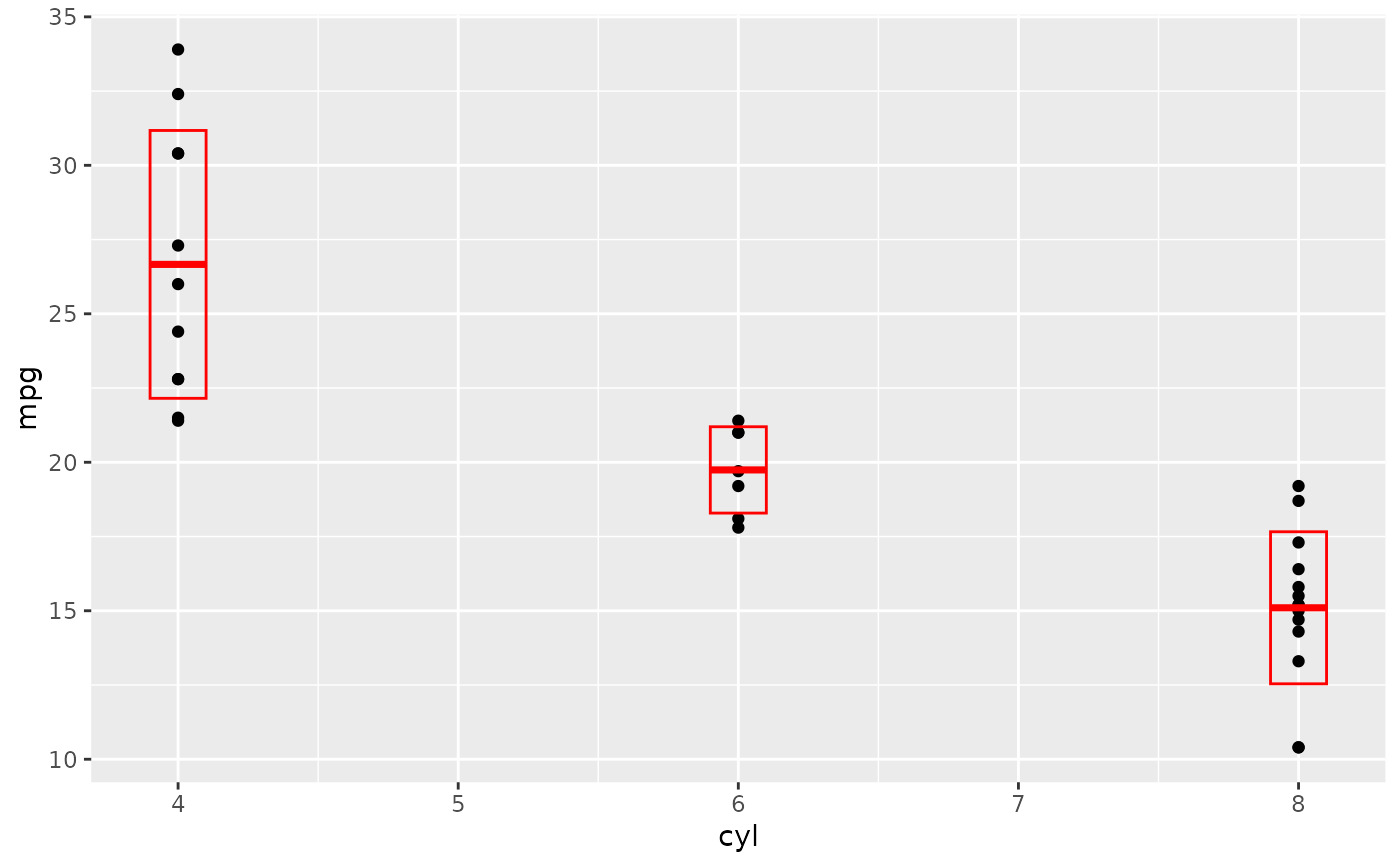 d + stat_sum_df("median_hilow", mapping = aes(group = cyl))
d + stat_sum_df("median_hilow", mapping = aes(group = cyl))
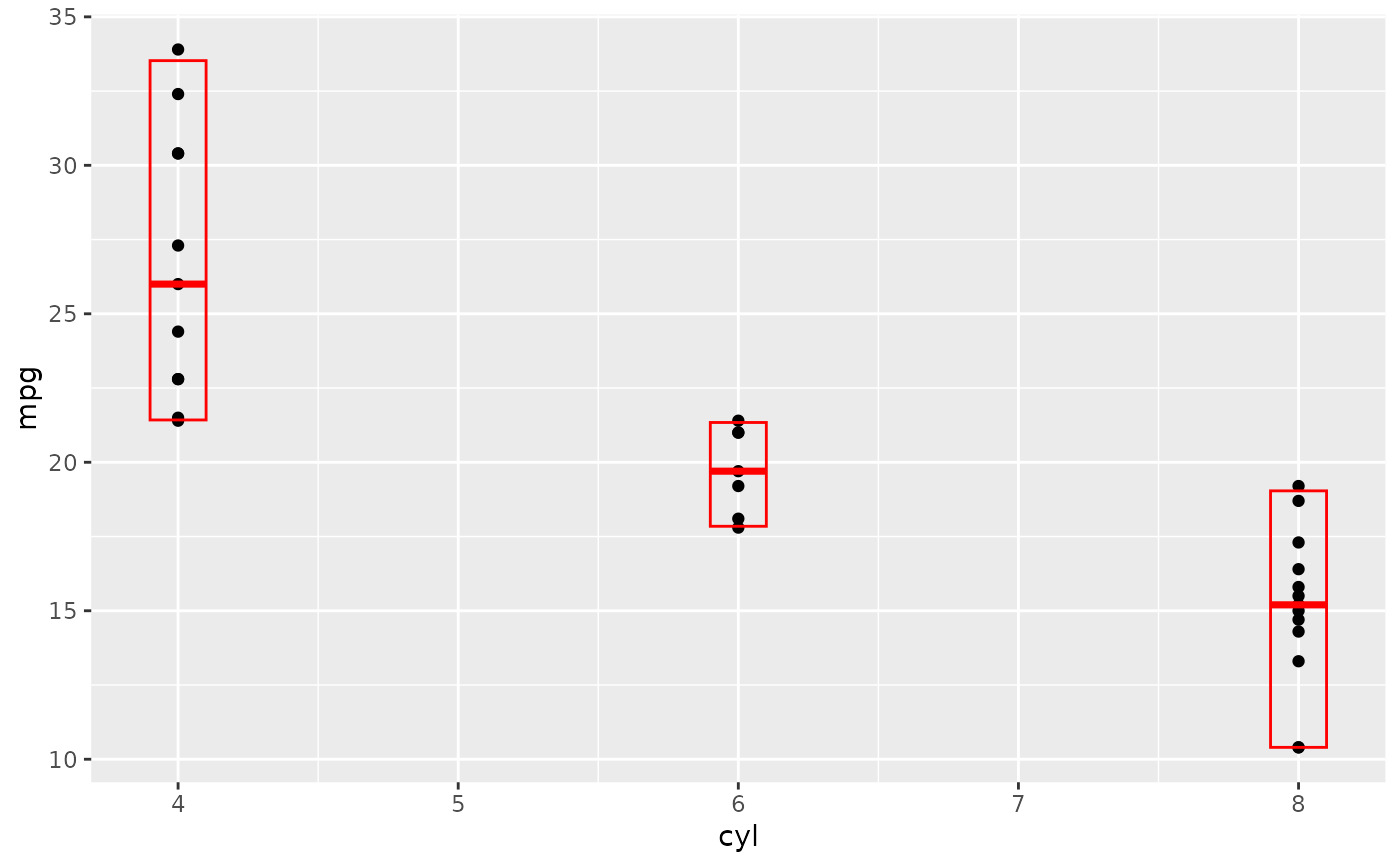 # An example with highly skewed distributions:
if (require("ggplot2movies")) {
set.seed(596)
mov <- movies[sample(nrow(movies), 1000), ]
m2 <-
ggplot(mov, aes(x = factor(round(rating)), y = votes)) +
geom_point()
m2 <-
m2 +
stat_summary(
fun.data = "mean_cl_boot",
geom = "crossbar",
colour = "red", width = 0.3
) +
xlab("rating")
m2
# Notice how the overplotting skews off visual perception of the mean
# supplementing the raw data with summary statistics is _very_ important
# Next, we'll look at votes on a log scale.
# Transforming the scale means the data are transformed
# first, after which statistics are computed:
m2 + scale_y_log10()
# Transforming the coordinate system occurs after the
# statistic has been computed. This means we're calculating the summary on the raw data
# and stretching the geoms onto the log scale. Compare the widths of the
# standard errors.
m2 + coord_trans(y="log10")
}
# An example with highly skewed distributions:
if (require("ggplot2movies")) {
set.seed(596)
mov <- movies[sample(nrow(movies), 1000), ]
m2 <-
ggplot(mov, aes(x = factor(round(rating)), y = votes)) +
geom_point()
m2 <-
m2 +
stat_summary(
fun.data = "mean_cl_boot",
geom = "crossbar",
colour = "red", width = 0.3
) +
xlab("rating")
m2
# Notice how the overplotting skews off visual perception of the mean
# supplementing the raw data with summary statistics is _very_ important
# Next, we'll look at votes on a log scale.
# Transforming the scale means the data are transformed
# first, after which statistics are computed:
m2 + scale_y_log10()
# Transforming the coordinate system occurs after the
# statistic has been computed. This means we're calculating the summary on the raw data
# and stretching the geoms onto the log scale. Compare the widths of the
# standard errors.
m2 + coord_trans(y="log10")
}
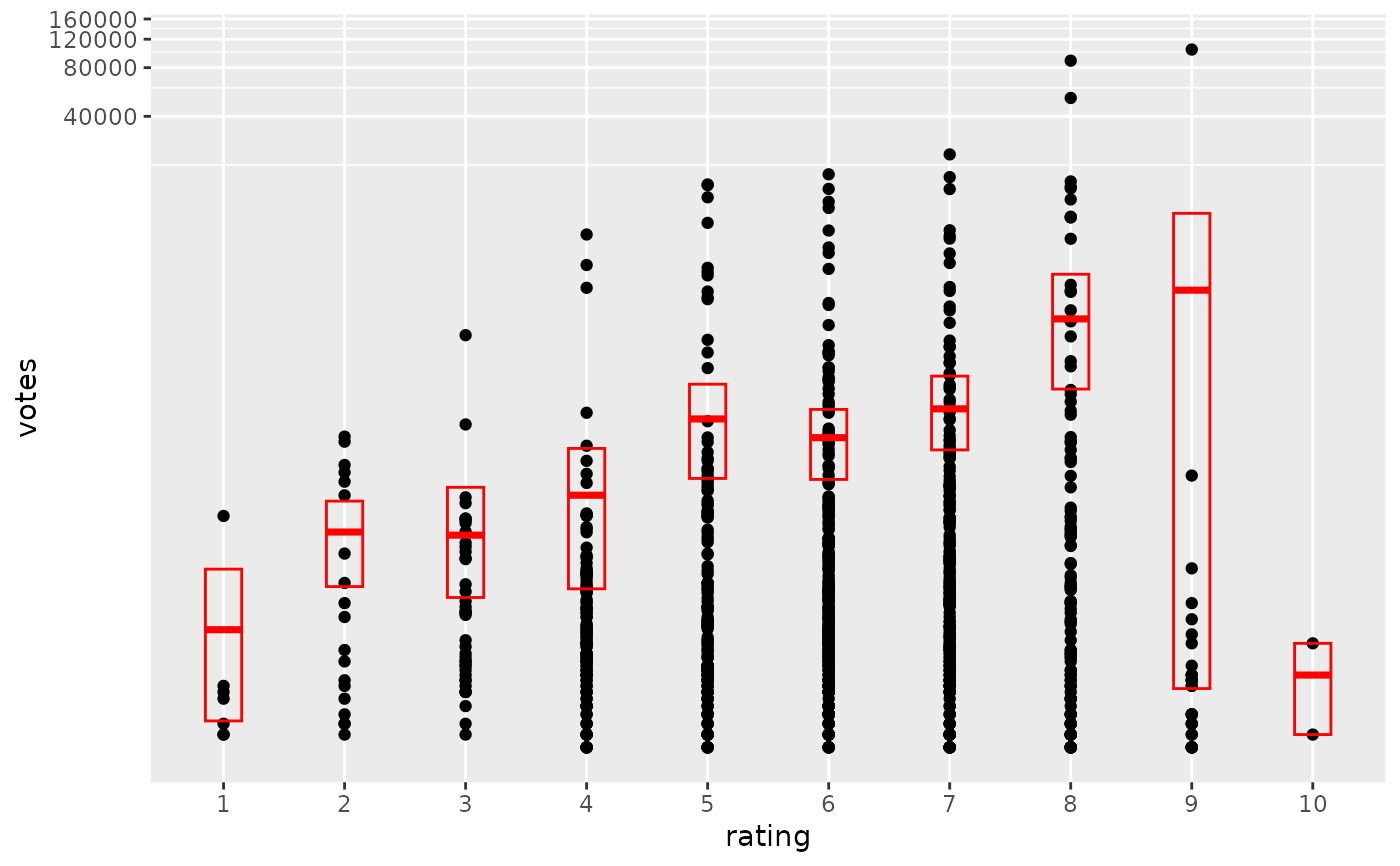 # }
# }
相關用法
- R ggplot2 stat_summary_2d 以二維形式進行分類和匯總(矩形和六邊形)
- R ggplot2 stat_sf_coordinates 從“sf”對象中提取坐標
- R ggplot2 stat_ellipse 計算法行數據橢圓
- R ggplot2 stat_identity 保留數據原樣
- R ggplot2 stat_unique 刪除重複項
- R ggplot2 stat_ecdf 計算經驗累積分布
- R ggplot2 scale_gradient 漸變色階
- R ggplot2 scale_shape 形狀比例,又稱字形
- R ggplot2 scale_viridis 來自 viridisLite 的 Viridis 色標
- R ggplot2 scale_grey 連續灰度色階
- R ggplot2 scale_linetype 線條圖案的比例
- R ggplot2 scale_discrete 離散數據的位置尺度
- R ggplot2 scale_manual 創建您自己的離散尺度
- R ggplot2 scale_colour_discrete 離散色階
- R ggplot2 scale_steps 分級漸變色標
- R ggplot2 should_stop 在示例中用於說明何時應該發生錯誤。
- R ggplot2 scale_size 麵積或半徑比例
- R ggplot2 scale_date 日期/時間數據的位置刻度
- R ggplot2 scale_continuous 連續數據的位置比例(x 和 y)
- R ggplot2 scale_binned 用於對連續數據進行裝箱的位置比例(x 和 y)
- R ggplot2 sec_axis 指定輔助軸
- R ggplot2 scale_alpha Alpha 透明度比例
- R ggplot2 scale_colour_continuous 連續色標和分級色標
- R ggplot2 scale_identity 使用不縮放的值
- R ggplot2 scale_linewidth 線寬比例
注:本文由純淨天空篩選整理自Hadley Wickham等大神的英文原創作品 Summarise y values at unique/binned x。非經特殊聲明,原始代碼版權歸原作者所有,本譯文未經允許或授權,請勿轉載或複製。
